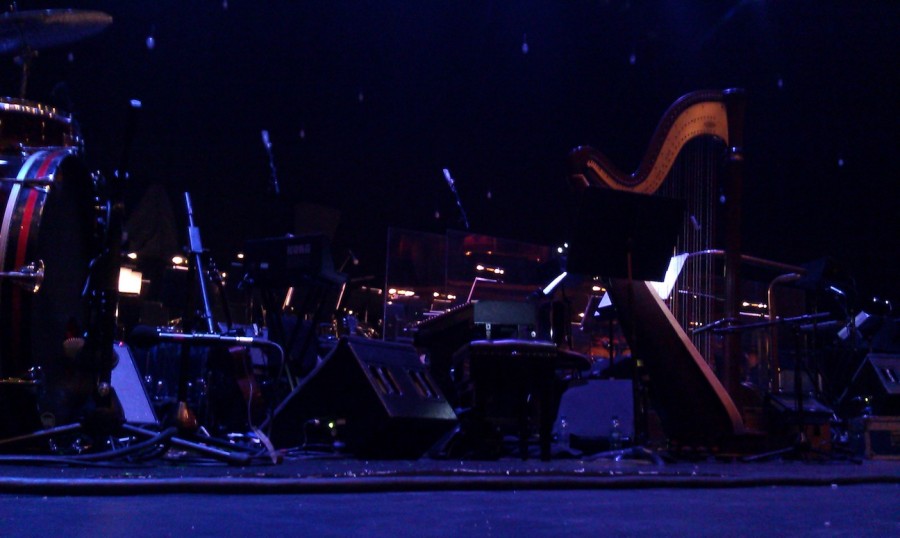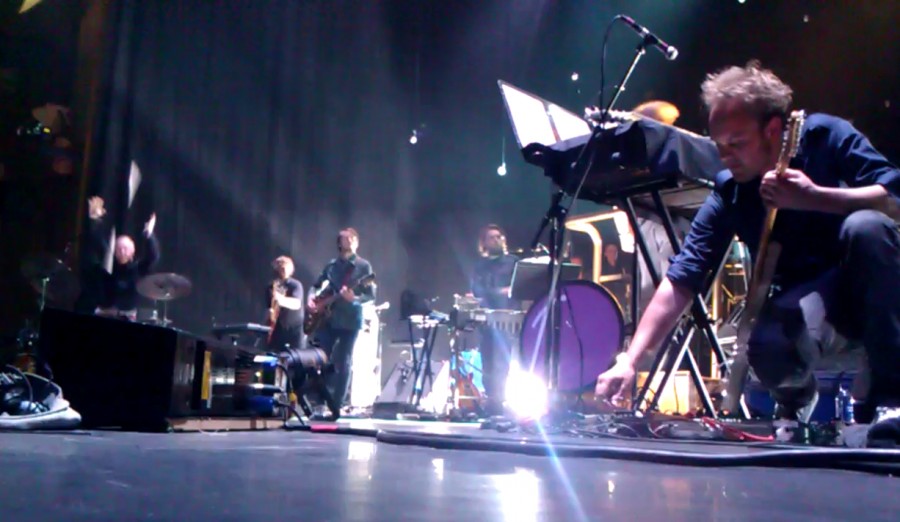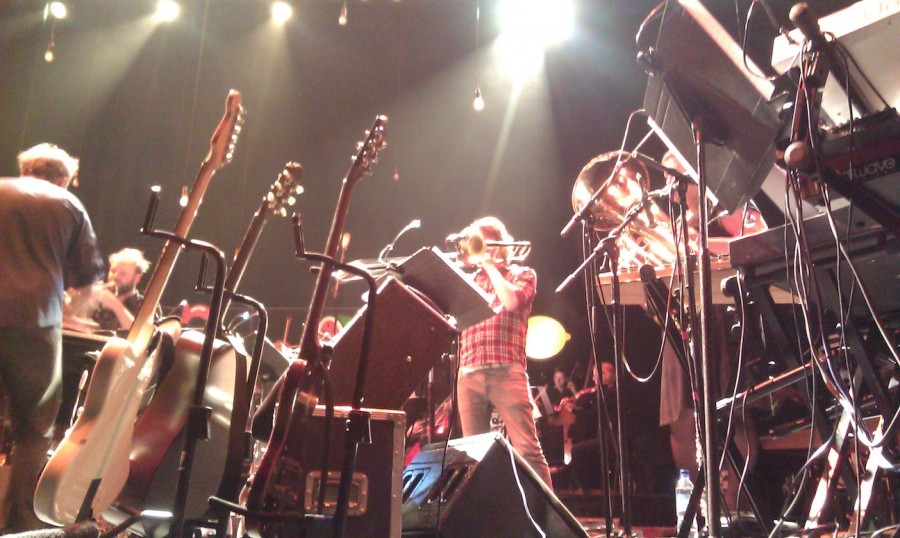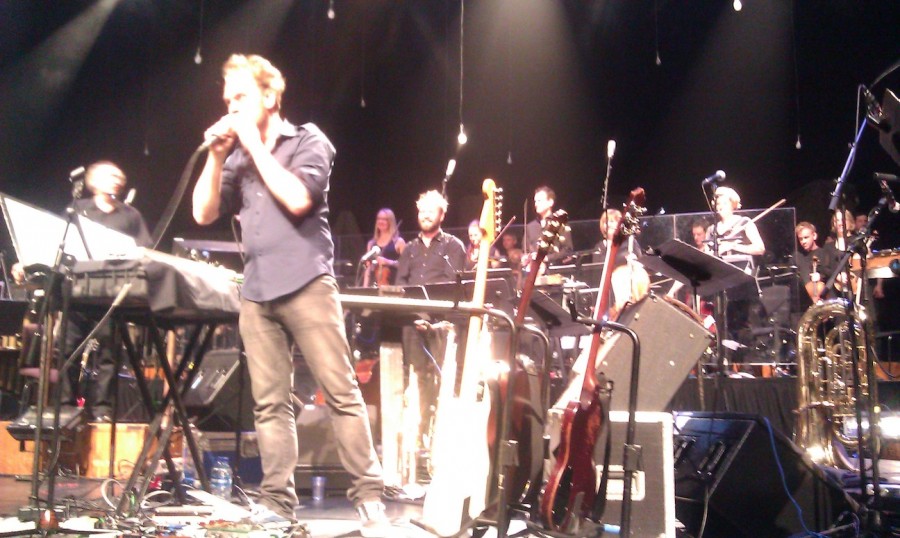I have been a devoted fan of Jaga Jazzist, a Norwegian group (they pretty much defy description) since around 2003, when I heard one of their tracks on a sampler CD issued by the Norwegian Embassy in London. This is the third gig of theirs I have been to. The first two were in the normal venues you would expect, with a lot of space for movement in response to the music.

This one was a bit special though. They were working in collaboration with the Britten Sinfonia, at the Barbican in London, and there were special symphonic arrangements of their tracks. The arrangements for orchestra really gave a different view on the original kernel of the each track. The concept was beautiful and the execution was spectacular.

How on earth?
A lot of their music (increasingly in the later work) is based on slow harmonic shifts, with various parts intertwingling and the craziest polyrhythms you probably can’t imagine. To my mind, Lars Horntveth approached the orchestration in three distinct ways.
First, he distilled the theme of the piece and gave the orchestra themes and variations to play. This got a few of the tracks off to an enigmatic start as it was sometimes a bit of a challenge to tease the theme out of the variation, match it to the original track and work out what was coming up. Even the ‘conventional’ tracks are often so far derived from their themes, circling them slowly, that in one or two cases I couldn’t work out what was going on. This way a handful of tracks started.
Second, he picked out the moving harmonic structure with the orchestra, or used it to double parts in the band. This meant that the tracks as they were performed felt exactly like the originals, except with a broader, more orchestral feel. There was quite a clash of timbres going on: the music of Jaga Jazzist is, and has increasingly been, instrumental. It’s mostly played on Slide Guitar, Guitar, Saxophone, Piano, Flute, Tuba, Vibraphone, Trumpet, Trobmone, Piano, Harp and Synths (and others). Where they employed a lot of electronic synthesising and finessing on earlier albums, the last couple have felt more straightforward and un-meddled. Even if the sound is that of real instruments, they use them in interesting ways. Lars uses a slide guitar (more than I thought, in hindsight), the vibraphone player often uses a ‘cello bow and there is an impressive array of guitar pedals. They have a specific sound. This sound went well with the orchestra in parts for most of the concert, but did jar a little from time to time.
Thirdly, the orchestra got really stuck in. The track that got me hooked back in 2003, Kitty Wu features very close interplay between two instruments (a clarinet or sax and a glockenspiel). This was re-worked to give the string section one half of the counterpoint. You can only get a certain amount of precision from a string section playing pizz. If you know JJ’s work, you’ll know how tight the music requires them to be, and how tight they are. That part of Kitty Wu got a little lost somewhere in the interplay.

Superhuman drums
I’m not a drums person, but every time I see Martin Horntveth play the drums I am taken to another level. I’m sure it meddles with alpha brain waves. It’s easy to listen to a CD and think ‘that’s a nice rhythm’ or even ‘that’s complex’ but seeing him live is unlike anything else I have ever experienced. He seemed to spend most of the gig on another plane of existence to everyone else. His arms were everywhere, he had a look of rapture on his face throughout and seemed to be having a thoroughly transcendental time of it. And we got to share in that. They rhythm of the melodic parts of most of their tracks are highly sophisticated, but it’s nothing compared to what Martin gets up to. Listen to one of their tracks, almost any of them, and just think that a real person is playing that live. It’s not a drum machine, although machine would be a good way to describe Martin. It would be impossible for a human to play straight demisemiquavers at that speed, let alone do interesting stuff with them.

This was an absolutely brilliant gig. I was lucky enough to get front-row tickets, and was absolutely blown away. Jaga Jazzist are absolutely my favourite musical group and I know every single one of their tracks note for note. Like any devotee, I automatically adopt a defensive attitude to meddling. Despite anything negative I might have written, the orchestration and execution of the group were absolutely spot on. Lars talked about ‘murdering his children’ (or something like that). True, the tracks were picked apart, but they were put together expertly, and in a way that produced a parallel execution of the germ of each track. Two manifestations of the same idea, kind of like the Spydeberg Sessions early recordings of tracks that became What we Must.
This was a once in a lifetime gig which I will always remember. If they repeated it, exactly the same, I would go again at the drop of a hat.
The sound and lighting did the music justice, as ever. Which is to say, dazzling, brilliant, evocative and very special. The matrix of dangling light bulbs especially gave a magical quality to the air.

Tied Ends
The act of using an orchestra had a very interesting effect on me. It tied up a couple of loose ends that I didn’t know were loose. The orchestra was the Britten Sinfonia, named after Benjamin Britten, a thoroughly modern composer. Hearing these tracks that I knew so well, coming out of a hard-to-define genre somewhere between jazz, electronica and high-concept rock, transformed into a more traditional orchestra setting lent a certain sound to them that I hadn’t associated with them before. This sound was reminiscent of works by Britten or Stravinsky. The opening of Toccatta, conventionally played on a vibraphone, was done by the orchestra. You’d be forgiven for thinking that it was Glass or Reich.
All composers use the tools they have available to express the musical ideas that they want to express. The experience of that music is couched in the language and expressive capability of its orchestration. JJ’s arrangements have very high specificity and accuracy, but they blend into one another somewhat in the mixdown. The musical parts are designed to do this, and I suspect they compose their pieces with instruments in hand. Pulling those lines out, making them explicit again and playing them with different instruments broke some of the comfortable cohesion and really made explicit a lot of the genius inner workings of the tracks. As someone who listens to tracks of all genres repeatedly in order to tease out the essence of the composer’s intention, I saw this as a Very Good Thing Indeed.
I have a feeling that the Horntveths and Britten might be each others’ analogues in different generations. What would Lars and Martin have done 100 years ago? What would Britten and Stravinsky have done today?
The effect of this transposition of arrangement and timbre was to put Jaga Jazzist onto the same continuum as a lot of other historical music I respect. There is a mental gap in my mind between contemporary music and the scale onto which I project modern, romantic, classical, baroque and medieval. (Traditional / folk music, another big part of my life, also exists as ‘other’ although Vaughan-Williams did his best to counter that). I felt the gap between Jaga Jazzist and the likes of Steve Reich and Rachmaninov closing. I never really thought about it, but I suppose if someone had asked me before the gig I would have said that I placed them on the same spectrum by default. I now realise that I really hadn’t. It took that experience to make the link.
I have a feeling that this feeling might be shared by all modernists throughout history on some level.
There exist plenty of clumsy attempts to play old rock songs by orchestras. They litter Spotify. Some are better than others. But they always sound a little forced and fake. There’s a reason why the composer of the track chose the instruments they chose. The great orchestral composers had little choice, but the rock bands made the best choice possible to convey their message. A string orchestra playing Queen hits will not suddenly make it ‘classical’, a choir doing a bodge-job of chanting Beatles songs will not suddenly make it ‘Gregorian chant’. They are at best musical oddities, and do nothing to reconcile the originals with the genre for which the instrumentation was mugged and left for dead.
But this gig really did do that. It made me think of Jaga Jazzist as pioneering modern composers rather than just my favourite group.
A mulling-over kind of end for a blog post. The gig left me transported to a higher plane of consciousness, my head spinning a little. Able to negotiate public transport home, but only just.
Congratulations Jaga Jazzist. Congratulations Lars and Martin, and the rest of the group. A beautiful, ambitious idea. An opportunity you deserved, spectacularly executed.
![][7]![][7]
[7]: /wp-includes/js/tinymce/plugins/wpgallery/img/t.gif “gallery link=“file” order=“DESC” orderby=“post_date””